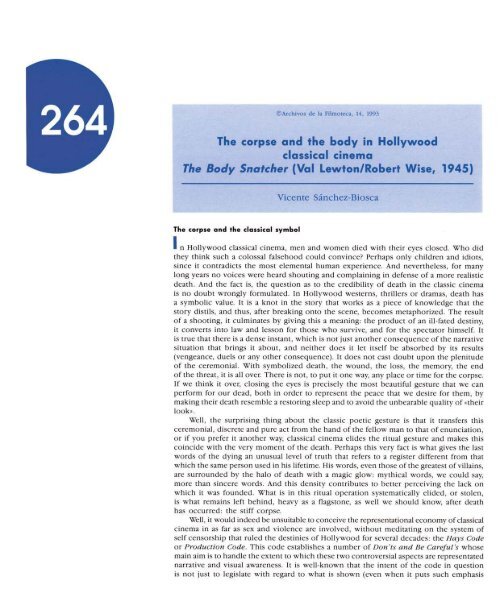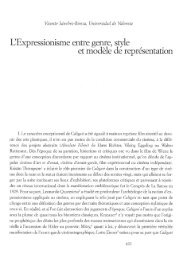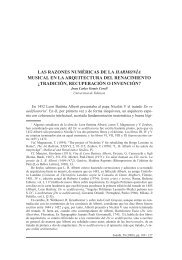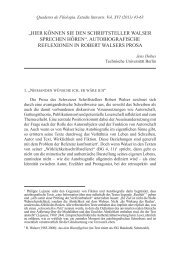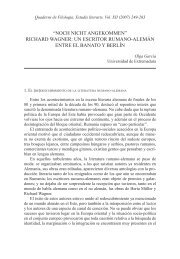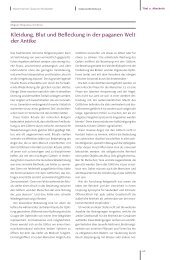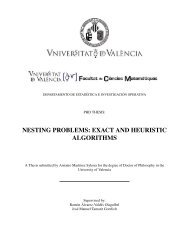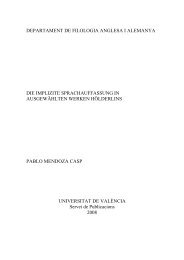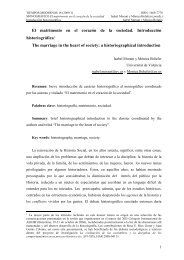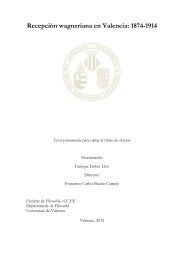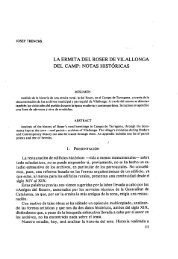The corpse and the body in Hollywood classical cinema ... - Roderic
The corpse and the body in Hollywood classical cinema ... - Roderic
The corpse and the body in Hollywood classical cinema ... - Roderic
You also want an ePaper? Increase the reach of your titles
YUMPU automatically turns print PDFs into web optimized ePapers that Google loves.
©Archivos ck la fllmo1cca, M. 1993<br />
<strong>The</strong> <strong>corpse</strong> <strong>and</strong> <strong>the</strong> <strong>body</strong> <strong>in</strong> <strong>Hollywood</strong><br />
<strong>classical</strong> c<strong>in</strong>ema<br />
<strong>The</strong> Bocly Snatcher (Val Lewton/Robert Wise, 1945)<br />
Vicente Sanchez-Biosca<br />
<strong>The</strong> <strong>corpse</strong> <strong>and</strong> <strong>the</strong> <strong>classical</strong> symbol<br />
I n Holly wood <strong>classical</strong> c<strong>in</strong>ema, men <strong>and</strong> w omen died w ich <strong>the</strong>ir eyes closed. W ho did<br />
chey ch<strong>in</strong>k such a colossal fal sehood could conv<strong>in</strong>ce? Perhaps o nly children <strong>and</strong> idiors,<br />
s<strong>in</strong>ce ic contradicts <strong>the</strong> most elemental human experience. And never<strong>the</strong>less, for many<br />
long years no voices were heard sho ut<strong>in</strong>g <strong>and</strong> compla<strong>in</strong><strong>in</strong>g <strong>in</strong> defense o f a more realistic<br />
death. And <strong>the</strong> fac t is, <strong>the</strong> question as to <strong>the</strong> credibility o f death <strong>in</strong> che classic c<strong>in</strong>ema<br />
is no doubt w rongl y formulated. In Holly wood westerns, thr illers or dramas, deach has<br />
a symbolic value. It is a kno c <strong>in</strong> <strong>the</strong> stor y that works as a piece o f know ledge that <strong>the</strong><br />
swry distils, <strong>and</strong> thus, after break<strong>in</strong>g onto <strong>the</strong> scene, becomes metaphorized. <strong>The</strong> resul t<br />
o f a shoot<strong>in</strong>g, i t culm<strong>in</strong>ates by giv<strong>in</strong>g this a mean<strong>in</strong>g: <strong>the</strong> p roduc t o f an ill-fated d est<strong>in</strong>y,<br />
it converts <strong>in</strong>to law <strong>and</strong> lesson for those who survive, <strong>and</strong> for <strong>the</strong> spectator himsel f. It<br />
is true chat <strong>the</strong>re is a dense <strong>in</strong>stant, which is nor just ano cher consequence o f <strong>the</strong> narrative<br />
situation that br<strong>in</strong>gs it about, <strong>and</strong> nei<strong>the</strong>r d oes ic let itsel f be absorbed by its results<br />
(vengeance, duels or any o <strong>the</strong>r consequence). le d oes no t case d oubt upon <strong>the</strong> p lenitude<br />
o f <strong>the</strong> ceremonial. With symbolized death, <strong>the</strong> wound, <strong>the</strong> loss, che memory, che end<br />
o f <strong>the</strong> threat, it is all over. <strong>The</strong>re is no r, co put it o ne way, any p lace or rime for <strong>the</strong> <strong>corpse</strong>.<br />
If we th<strong>in</strong>k it over, clos<strong>in</strong>g <strong>the</strong> eyes is precisel y che mosc beauciful gescure that we can<br />
perform for our d ead, bo th <strong>in</strong> order to represent <strong>the</strong> peace that we desire for chem, by<br />
mak<strong>in</strong>g <strong>the</strong>ir death resemble a restor<strong>in</strong>g sleep <strong>and</strong> to avoid <strong>the</strong> unbearable quality of •<strong>the</strong>ir<br />
look •.<br />
Well, <strong>the</strong> surpris<strong>in</strong>g th<strong>in</strong>g about t11e classic poetic gesture is that it transfers chis<br />
ceremo nial, discrete <strong>and</strong> pure act from <strong>the</strong> h<strong>and</strong> o f <strong>the</strong> fellow man to that of enunciation,<br />
o r i f you prefer it ano <strong>the</strong>r way, <strong>classical</strong> c<strong>in</strong>ema elides <strong>the</strong> ritual gesture <strong>and</strong> makes chis<br />
co<strong>in</strong>cide w ith <strong>the</strong> very moment o f <strong>the</strong> death. Perhaps this ver y fact is w hat gi ves <strong>the</strong> last<br />
words o f <strong>the</strong> d y<strong>in</strong>g an unusual level o f truth that refers to a register different from that<br />
which che same person used <strong>in</strong> his lifetime. His words, even those o f <strong>the</strong> greatest of villa<strong>in</strong>s,<br />
are surrounded by che halo o f death w ith a magic glow: mychical words, we could say,<br />
more than s<strong>in</strong>cere words. And this density contributes co better perceiv<strong>in</strong>g <strong>the</strong> lack on<br />
which it was founded . What is <strong>in</strong> this ritual op eratio n systematically elided , or swlen ,<br />
is whac rema<strong>in</strong>s left beh<strong>in</strong>d, heavy as a flagsto ne, as well we should know, after death<br />
has occurred: <strong>the</strong> stiff <strong>corpse</strong>.<br />
Well, it would <strong>in</strong>deed be unsuitable to conceive <strong>the</strong> representational economy o f <strong>classical</strong><br />
c<strong>in</strong>ema <strong>in</strong> as far as sex <strong>and</strong> violence are <strong>in</strong>volved, w ithout m edicat<strong>in</strong>g on <strong>the</strong> system of<br />
self censorship that ruled <strong>the</strong> dest<strong>in</strong>ies o f <strong>Hollywood</strong> for several decades: <strong>the</strong> Hays Code<br />
or Productio n Code. This code establishes a number of Do n 'ts <strong>and</strong> Be Carefu.l 's whose<br />
ma<strong>in</strong> aim is to h<strong>and</strong>le <strong>the</strong> extent lO which <strong>the</strong>se two controversial aspects are represenrated<br />
narrative <strong>and</strong> visual awareness. It is well-known chat <strong>the</strong> <strong>in</strong>tent o f <strong>the</strong> code <strong>in</strong> question<br />
is no t just co legislate with regard to what is shown (even when ir pucs such emphasis
on this) but r:l<strong>the</strong>r similarly extends to <strong>the</strong> evaluation of narrative questions <strong>and</strong> of <strong>the</strong>ir<br />
pragmatic function. It might be productive to stop look<strong>in</strong>g at this code as a means for<br />
repress<strong>in</strong>g th<strong>in</strong>gs shown (<strong>in</strong> a merely prohibitive ideological sense) so we can <strong>in</strong>stead underst<strong>and</strong><br />
<strong>the</strong> term repression <strong>in</strong> <strong>the</strong> psychoanalytical sense as given by Freud, whose mean<strong>in</strong>g<br />
proves to be far more productive. Put <strong>in</strong> this way, <strong>the</strong> purpo e of <strong>the</strong>se rules <strong>and</strong> <strong>the</strong>ir<br />
effect vary radically. Allow us this slight detour.<br />
For Freud, repres ion (Verdrii11g1111g) is <strong>the</strong> basic mechanism of <strong>the</strong> unconscious <strong>and</strong><br />
consists of <strong>the</strong> operation whereby <strong>the</strong> subject keeps representations l<strong>in</strong>ked to urges away<br />
from che unconscious. Bue, this operation cannot help leav<strong>in</strong>g its traces, even order<strong>in</strong>g<br />
behaviour <strong>and</strong>, above all, <strong>the</strong> discourse of che subject s<strong>in</strong>ce repression <strong>and</strong> <strong>the</strong> return<br />
of <strong>the</strong> repressed an: none o<strong>the</strong>r th:tn one <strong>and</strong> <strong>the</strong> same th<strong>in</strong>g. Lacan states this most exp<br />
licitly: •Verdrangung, repression, is no t <strong>the</strong> law of <strong>the</strong> misundcrst0od, it is what happens<br />
when someth<strong>in</strong>g docs not fit <strong>in</strong> on <strong>the</strong> level of <strong>the</strong> symbolic cha<strong>in</strong>. Each symbolic<br />
cha<strong>in</strong> lO which we are tied entails <strong>in</strong>ternal coherence, that at a given time forces us to<br />
return to ano<strong>the</strong>r wbat we receioed. Still, it may happen chat it is not possible for us<br />
co return on all levels at <strong>the</strong> same time, <strong>and</strong> that, <strong>in</strong> o<strong>the</strong>r terms, <strong>the</strong> law is <strong>in</strong>tolerable<br />
to u:.. 'ot because it is <strong>in</strong> itself. but ra<strong>the</strong>r because <strong>in</strong> <strong>the</strong> position <strong>in</strong> which we f<strong>in</strong>d<br />
our elves a sacrifice is implied that proves to be impossible on <strong>the</strong> plane of mean<strong>in</strong>gs.<br />
And <strong>the</strong>n we repres : our acts, our speech, our behaviour. But <strong>the</strong> cha<strong>in</strong>, <strong>in</strong> any event,<br />
goes on circulat<strong>in</strong>g down below, express<strong>in</strong>g its requirements, call<strong>in</strong>g to attention <strong>the</strong> debt<br />
owed it, <strong>and</strong> it docs this by means of <strong>the</strong> <strong>in</strong>termediary of che neurotic symptom•.'<br />
<strong>The</strong> operation that is deduced from repression is thus perceptible <strong>in</strong> <strong>the</strong> discourse,<br />
it constitutes its fundamental axis, :md thus what is repressed fights to reappear <strong>in</strong> <strong>the</strong><br />
cha<strong>in</strong> of signifiers. \'(le could conceive or what occurs with <strong>the</strong> I lays code <strong>in</strong> this way:<br />
its rul<strong>in</strong>g, <strong>the</strong> obstacles that it imposes aga<strong>in</strong>st display <strong>and</strong> narr~uion constitute an operation<br />
of repression that, <strong>in</strong> spite of it all, will not be able - it is its law- to prevent what<br />
is repressed, cont<strong>in</strong>ually return<strong>in</strong>g <strong>in</strong> elusive, metaphorical shapes. It is thus that a<br />
mechanbm of suggestions is generated that historiography denom<strong>in</strong>ates classic sense of<br />
sbame. Its basic <strong>in</strong>struments are noc :.o much suppression, (1hi is what would correspond<br />
<strong>in</strong> Freudian term<strong>in</strong>ology to Venl'e1f1111g or foreclosure) as <strong>the</strong> start<strong>in</strong>g up of <strong>the</strong> whole<br />
rhetorical r:lnge, preterition, ellipsi:-. <strong>and</strong> above all metonymy <strong>and</strong> metaphor, <strong>in</strong> order to<br />
cover up what cannot cease t0 be announced <strong>in</strong> spite of prohibitions. We could affirm,<br />
<strong>in</strong> virtue of what we have said. that <strong>the</strong> lns1itu1ional Mode of Representation constiru1es<br />
<strong>the</strong> effect <strong>in</strong> <strong>the</strong> discourse (transformations, metaphors, meLOn)'mies, lito tes, ellipsis, etc.)<br />
of <strong>the</strong> prohibitions formulated or recommended <strong>in</strong> <strong>the</strong> Code of production. And s<strong>in</strong>ce<br />
we arc deal<strong>in</strong>g with rhetorical figures, <strong>classical</strong> discourse would cont<strong>in</strong>ually draw back<br />
<strong>the</strong> frontier, not so much <strong>in</strong> order to transgress <strong>the</strong> model (as would have been said some<br />
year:, ago with note of praise), as to establish this <strong>in</strong> che precarious position of rhetorical<br />
balance ..<br />
In M> far a:. horror films arc concerned, this effect muse be co nsidered around chree<br />
fundament:il figures: firstly place <strong>the</strong> metamorphosis understood as violence imposed o n<br />
<strong>the</strong> :-.hape!> o f imag<strong>in</strong>ary human identification, <strong>and</strong> particularly a:. a momentary suspensio<br />
n of :.uch an anthropologically decisive dist<strong>in</strong>ction as that between what is animal <strong>and</strong><br />
what human. In this sense, <strong>and</strong> 10 take just one illustrative example, 1hc shame <strong>in</strong>volved<br />
<strong>in</strong> <strong>the</strong> transformation of <strong>the</strong> woman <strong>in</strong>to pan<strong>the</strong>r, that happens outside <strong>the</strong> visual field<br />
<strong>in</strong> Cat People, by Jacques 'lburneur. 1943, (<strong>and</strong> <strong>the</strong> correlative of m:1<strong>in</strong>ta<strong>in</strong><strong>in</strong>g che ambiguity<br />
up of <strong>the</strong> doubt as to whe<strong>the</strong>r she has been operated on or not) contrasts with its<br />
<strong>in</strong>vasio n of <strong>the</strong> field <strong>and</strong> exhibition to everyone's gaze <strong>in</strong> all it:-. <strong>in</strong>termediate phases <strong>in</strong><br />
<strong>the</strong> film with <strong>the</strong> same name (<strong>in</strong> fact a remake) by Paul chradcr, !>hot <strong>in</strong> 1982).; ccondly,<br />
<strong>the</strong> violence <strong>the</strong> human <strong>body</strong> i:, subjected to is restra<strong>in</strong>ed by an economy of movement<br />
(murder:-. out o f our wiew, m1:t0nymic effects from cause to effec t between <strong>the</strong> murder<br />
weapon <strong>and</strong> <strong>the</strong> w ounded <strong>body</strong>). This is radically oppo:-.ed to <strong>the</strong> ritual of <strong>the</strong> knif<strong>in</strong>g<br />
1 J;acquc' l.:ic2n FI ~em 1 11a t"1t><br />
'"'"'' i I as Psfros1s. B:un2 8u('no'<br />
Aire' " "'"'" P:11d6•. 19tH, l'.ISS l'.l~h<br />
IC, t . J'l Ill<br />
' <strong>The</strong> 'uh1ctt or <strong>the</strong> ~ode. at~ fron<br />
tier' .<strong>and</strong> lh v:.luc .. ~ "'" w2\ dc;alt w i1h<br />
In J rcu:nt volu me . J>,..,,,,a 1l r1 totllu 1<br />
Al/(• /"""' ,.. :u prcst-n1 1n prim
<strong>and</strong> <strong>the</strong> axe blow <strong>in</strong> <strong>the</strong> modern gory spectacle. Lastly, dur<strong>in</strong>g <strong>the</strong> <strong>classical</strong> period, <strong>the</strong><br />
represemation of Gothic monstrosity held sway over <strong>the</strong> real monster. (Freaks, directed<br />
by Tod Brown<strong>in</strong>g <strong>in</strong> 1932, constitutes an exemplary case, but equally unusual: <strong>the</strong> dom<strong>in</strong>ant<br />
style has to be seen <strong>in</strong> <strong>the</strong> figures of Dracula, <strong>the</strong> ~lummy, <strong>the</strong> Wolf man, etc). Real<br />
monsters, com<strong>in</strong>g from genetic experiments, biology or some k<strong>in</strong>d of organic degeneration<br />
scemm<strong>in</strong>g from epidemics arc, on <strong>the</strong> contrar)•, <strong>the</strong> spoiled children of today's modern<br />
terror.• <strong>The</strong>re can be no doubt, <strong>in</strong> this process that we arc chat quickly summ<strong>in</strong>g up,<br />
<strong>the</strong> ostracism of <strong>the</strong> <strong>corpse</strong> is also :1n effect of <strong>the</strong> discourse: buc <strong>the</strong> <strong>corpse</strong> <strong>in</strong> <strong>Hollywood</strong><br />
films lives, though hidden aw:ty, <strong>in</strong> some pl:tcc beyond <strong>the</strong> death that gave birth to it,<br />
to use a paradox of language.<br />
<strong>The</strong> explosion of <strong>the</strong> <strong>corpse</strong> <strong>in</strong> modern horror films<br />
• In rcu~nt \\mcrn.:.ln ''Jhoric
as it is lack<strong>in</strong>g <strong>in</strong> imensity. imilarly, <strong>the</strong> stor y itself suffers from <strong>the</strong> same awful illness<br />
<strong>and</strong> is shown to be <strong>in</strong>capable of dy<strong>in</strong>g away, proceed<strong>in</strong>g to resurrections that contradict<br />
any k<strong>in</strong>d of discursive logic.• In so far as m<strong>in</strong>eralization i concerned, this represents a<br />
stage that is worthy of <strong>the</strong> human be<strong>in</strong>g <strong>in</strong> o far as <strong>the</strong> bod)' becomes a sort of archaeology<br />
that i deposited <strong>in</strong> memory <strong>and</strong> history with no material <strong>in</strong>tervention of life. Perhaps<br />
for this reason, it offers such little visual <strong>in</strong>terest.<br />
Why <strong>the</strong>n should this putrefaction, this fearful b<strong>in</strong>h of life after life, become <strong>the</strong> favorite<br />
motif of horror films, even if its first object were <strong>the</strong> <strong>corpse</strong>. It would be sufficient, to<br />
respond to this question, LO direct our m<strong>in</strong>ds to <strong>the</strong> quantity of rituals that throughout<br />
history have au empted to elim<strong>in</strong>ate or at lease to neurralize <strong>the</strong> irrecoverable effects of<br />
this stage, doubtlessly <strong>the</strong> most degrad<strong>in</strong>g one, of human decomposition. But at <strong>the</strong> o<strong>the</strong>r<br />
end, <strong>and</strong> as proof of <strong>the</strong> opposite argument, it may be remembered that a large pan of<br />
<strong>the</strong> perverse fantasies which literature has so o ften chosen are also found to lie around<br />
this stage of <strong>the</strong> <strong>corpse</strong>. <strong>The</strong> icily chemical description that Thomas offers may be of<br />
use to us to identif)' some of <strong>the</strong> most compulsive poles of attraction o f <strong>the</strong> c<strong>in</strong>ema of<br />
terror: • It swells up <strong>in</strong> an <strong>in</strong>ord<strong>in</strong>ate way, <strong>and</strong> can atta<strong>in</strong> twice its volume, especially <strong>the</strong><br />
C)• clid~. <strong>the</strong> lips, <strong>the</strong> abdomen <strong>and</strong> <strong>the</strong> scrotum. It is repugnant due LO <strong>the</strong> brown coloured<br />
discharges, st<strong>in</strong>k<strong>in</strong>g <strong>and</strong> sicken<strong>in</strong>g, that come out of <strong>the</strong> nasal orifices, <strong>the</strong> mouth, <strong>the</strong><br />
anus <strong>and</strong> m times from <strong>the</strong> cars. I! emits foul gases that carry <strong>the</strong> bac teria of putrefaction.<br />
This phenomenon is given <strong>the</strong> name of postbumous circulation . <strong>The</strong> putrid fermentation<br />
docs <strong>in</strong>deed produce plcnriful water b ut also methane, carbon dioxide gas, nitrogen, ammonia,<br />
sulphurous hydrogen <strong>and</strong> trymethylam<strong>in</strong>c. <strong>The</strong>se gases cause a swell<strong>in</strong>g of <strong>the</strong><br />
<strong>corpse</strong>, :tnd arc produced <strong>in</strong> such quantities chat if a release va lve is no t placed <strong>in</strong> <strong>the</strong><br />
coff<strong>in</strong>, <strong>the</strong>re is a risk o f <strong>the</strong> latter's explod<strong>in</strong>g. Lastly, it transforms <strong>the</strong> flesh, already soft<br />
<strong>and</strong> weak, <strong>in</strong>to fetid, diffus<strong>in</strong>g <strong>and</strong> rou en look<strong>in</strong>g masses, wi1h colors that go from a free<br />
bronze weft to a yellowish b rown, <strong>the</strong>n on to green, <strong>and</strong> afterwards go<strong>in</strong>g to black with<br />
plates o f grqr black chat contrast with <strong>the</strong> white mould•.-<br />
This detailed approach to <strong>the</strong> real nature of decomposition, guided by an unambiguously<br />
scientific frame of m<strong>in</strong>d, has become imag<strong>in</strong>ary speculation <strong>in</strong> horror films. O r, to put<br />
it <strong>in</strong> 01her words, modern terror films amplify <strong>the</strong> details here described to <strong>the</strong> po<strong>in</strong>t<br />
of provok<strong>in</strong>g revulsion.A Three fa tes seem to em<strong>body</strong> this imag<strong>in</strong>ary projection of what<br />
science describes with <strong>the</strong> cold nature of a su rgeon <strong>in</strong> <strong>the</strong> quote above: firstl y, 1hc constant<br />
exhibitio n of <strong>corpse</strong>s <strong>in</strong> a state of putrefaction <strong>and</strong> <strong>the</strong>ir different stages of transfor-<br />
1rn11ion (that docs no t <strong>in</strong> any way imply <strong>the</strong>ir state of death - this be<strong>in</strong>g extremely impor <br />
tant). Pu trefaction has been freed, <strong>in</strong> this sense, from its dependence o n 1he medical death<br />
of <strong>the</strong> organism. For this reason we f<strong>in</strong>d such general p resence of <strong>the</strong> paradox of <strong>the</strong><br />
live <strong>corpse</strong> or <strong>the</strong> undead. <strong>The</strong> films of <strong>the</strong> liv<strong>in</strong>g dead by George A. Romero, 1hc remake<br />
made by ·1om av<strong>in</strong>i, as well as Lucio Fulci's excessive sequels, are 1he perfect expression<br />
of what we arc mention<strong>in</strong>g. ccondly, <strong>the</strong> appearance of cannibalism , o ften di tanr from<br />
any anthropological consideration. Like all alibis, it could be said that •flesh attracts flesh ..<br />
Tobe I looper's mythical films, start<strong>in</strong>g with <strong>the</strong> Texas Cha<strong>in</strong>saw Massacre, litcralizc <strong>the</strong><br />
ostensible •human butchery• metaphor, as is <strong>the</strong> case <strong>in</strong> some pieces of cul<strong>in</strong>ar y sarcasm<br />
by Jackie Kong or Peter Jackson. Thirdly, <strong>the</strong> dismember<strong>in</strong>g <strong>and</strong> loss of unify<strong>in</strong>g forms<br />
of <strong>the</strong> <strong>body</strong>, <strong>the</strong> ones that are used to recognize this as someth<strong>in</strong>g human <strong>and</strong> that susca<strong>in</strong><br />
<strong>the</strong> found<strong>in</strong>g image of its gestalt unity, <strong>the</strong> source of narcissism. Many fi lms by David<br />
Cronenberg proverbially represent this case, that <strong>in</strong> ano <strong>the</strong>r text we called <strong>the</strong> · fall of<br />
<strong>the</strong> <strong>body</strong>•. Do we need to add that we arc no w beyond <strong>the</strong> limit <strong>in</strong> which desire can<br />
act? <strong>The</strong>se bodies arc completely dc-eroticizcd.•<br />
,. <strong>The</strong> different :i.nd imcrmlnJblc<br />
t:h.1pc c~ un 1hc Stalkt~ t Films model, such<br />
;a, Frf
<strong>The</strong> <strong>corpse</strong> <strong>in</strong> <strong>classical</strong> c<strong>in</strong>ema: <strong>the</strong> limits of an absence<br />
We affirmed above that <strong>classical</strong> c<strong>in</strong>ema igno red <strong>the</strong> <strong>corpse</strong> <strong>in</strong> a strict sense. But this<br />
affirmation is at least a little <strong>in</strong>accurate. It would thus be fill<strong>in</strong>g to <strong>in</strong>uoduce some nuance<br />
that could beu er determ<strong>in</strong>e <strong>the</strong> loopholes <strong>and</strong> limits o f this law, that is, <strong>the</strong> discursive<br />
operation to which we alluded above, <strong>and</strong> its rhetorical figures that p lay on <strong>the</strong> boundaries.<br />
Even though our anal ysis i centred on Tbe Body Snatcb er (Robert Wise, 1945)<br />
it would no t be out o f p lace to <strong>in</strong>troduce a quick reference to ano <strong>the</strong>r of <strong>the</strong> mychical<br />
films with<strong>in</strong> <strong>the</strong> mo dest B series o f Holly wood 's fantastic genre, namely Frankenste<strong>in</strong><br />
Oames Whale, 1932). Bo th <strong>the</strong>se films arc representative o f each o f che most relevant cycles<br />
of B series films o f <strong>the</strong> thirties ;rnd forties (Carl Laemmic for Universal <strong>and</strong> Val Lewton<br />
for R.K.0. respec tively). Also <strong>the</strong> novelistic sources (Mary Shelley <strong>in</strong> <strong>the</strong> first case, Hoben<br />
Louis Stevenson <strong>in</strong> <strong>the</strong> second) provide <strong>the</strong> Gothic frame that helped co create <strong>the</strong> envelop·<br />
<strong>in</strong>g visual atmosphere required for this type o f stories. Fur<strong>the</strong>rmore, both films have scientiscs<br />
obsessed by <strong>the</strong> study o f life <strong>and</strong> d eath as <strong>the</strong> driv<strong>in</strong>g force beh<strong>in</strong>d <strong>the</strong> plot. It is<br />
no t strange <strong>in</strong> <strong>the</strong> slightest that <strong>the</strong> <strong>corpse</strong> should come forth co meet <strong>the</strong>m .<br />
We must clear up this question: this is no longer a matter o f deaths, but o f what<br />
follows on from <strong>the</strong>se, that is, <strong>the</strong> world o f dissection, o f dismember<strong>in</strong>g, o f <strong>the</strong> torn up<br />
bo dy. le is clear that bo th films arc found on different registers: Frankenste<strong>in</strong> talks to<br />
us o f an electrical apo <strong>the</strong>osis, of a metaphor about <strong>the</strong> Prome<strong>the</strong>an creation o f life that<br />
seems to bury <strong>the</strong> discour e o f <strong>the</strong> dead <strong>body</strong> that we talked ab out. ·cvenheless, it is<br />
enough to look at <strong>the</strong> film closely, sett<strong>in</strong>g aside current cliches, to be bl<strong>in</strong>ded by its material<br />
evidence. Tbe Body Snatcber comes for ward under a much m ore asphyxiat<strong>in</strong>g <strong>and</strong> raw<br />
face: here science has no th<strong>in</strong>g to do with alchemy or electricity, <strong>the</strong>re is no Gothic ecstasy.<br />
It is <strong>in</strong>stead <strong>the</strong> most straightforward expressio n of <strong>the</strong> wo rld o f medic<strong>in</strong>e <strong>and</strong> i ts encyclopedia,<br />
<strong>the</strong> <strong>corpse</strong>.••<br />
Fronlcenste<strong>in</strong>: parts of a <strong>body</strong><br />
"' E1 cc dt vollcmcm 1mpllqu211 ~<br />
.son cour commc ch:amp d 'o riitrnc et de<br />
nunifcsauon deb \'trill: t'c:Sp=acc dl.scur·<br />
slf du cad2vrc l'ln1t rlcur dt-·oilt L:a con·<br />
s1hullon de l'2n21omlc pa1holog1quc ~<br />
l'tpaquc o u le' chnlclcns dt Rnlss• lcm<br />
lcur mt 1hodc n'C$1 P>' de l'ordrc de 12<br />
co1ncldcncc. rtqulllbrc de l'cx~rlcncc<br />
voui.11 rd po~ sur l'lndlvldu<br />
cl le l>ng.gc de I• dcscrlp1lon rcposcm<br />
>U r le fond St>blc, vb1blc cl Ii.Ible. de I•<br />
mo n (Michel Pouc>uh. Nalssnn c~ d~ la<br />
cl/11/q11e, l".Jrls, PU.P., 196), p 200).<br />
Frankenste<strong>in</strong> has repeatedly been <strong>in</strong>terpreted as <strong>the</strong> empire o f <strong>the</strong> metaphor o f <strong>the</strong><br />
creation of life, imitat<strong>in</strong>g God. But this criteria has stoo d <strong>in</strong> <strong>the</strong> way of <strong>the</strong> brutally t
<strong>and</strong> <strong>the</strong> rema<strong>in</strong>s that give away his fragmentary past." A <strong>body</strong> that is, when all is said<br />
<strong>and</strong> done, a recomposed <strong>body</strong>, made by •bricolage• <strong>and</strong> bears on it, both pr<strong>in</strong>ted <strong>and</strong><br />
readable, <strong>the</strong> marks of its suture, of <strong>the</strong> sew<strong>in</strong>g toge<strong>the</strong>r of its pans. ow, this fragment<br />
of Frankenste<strong>in</strong> , that is <strong>in</strong>deed <strong>in</strong> no way marg<strong>in</strong>al, puts its impr<strong>in</strong>t onto <strong>the</strong> rest of <strong>the</strong><br />
film: a <strong>corpse</strong> is on <strong>the</strong> rampage <strong>and</strong> <strong>the</strong> traces of its birth arc, though transcended,<br />
no ne<strong>the</strong>less visible.<br />
If <strong>the</strong>re can be any doubt <strong>in</strong> this respect, it would be worth <strong>the</strong> reader's while to<br />
look at a scene from <strong>the</strong> sequel filmed by <strong>the</strong> same James Whale <strong>in</strong> 1935, T<strong>in</strong> Bride of<br />
Frankenste<strong>in</strong> <strong>in</strong> which <strong>the</strong> opposition between che cwo fact0rs <strong>in</strong>volved here <strong>the</strong> <strong>corpse</strong><br />
<strong>and</strong> <strong>the</strong> Prome<strong>the</strong>an metaphor is shown with didactic mastery. <strong>The</strong> s<strong>in</strong>ister Doctor<br />
Pretorious, undertak<strong>in</strong>g a compulsive piece of research as to <strong>the</strong> secret of life, shows Henry<br />
Frankenste<strong>in</strong> <strong>the</strong> resul ts of his <strong>in</strong>vestigatio n, consist<strong>in</strong>g o f a series of m <strong>in</strong>iatures kept <strong>in</strong><br />
glass jars that em<strong>body</strong> fairy talc characters (<strong>the</strong> k<strong>in</strong>g, <strong>the</strong> queen, <strong>the</strong> dancer). Someth<strong>in</strong>g<br />
is lack<strong>in</strong>g, <strong>the</strong> gloomy doctor po<strong>in</strong>ts out hurriedly, tO make <strong>the</strong>se results comparabl e with<br />
<strong>the</strong> achievements of Frankenste<strong>in</strong>: <strong>the</strong> size. But such a conclusion is only partly satisfy<strong>in</strong>g,<br />
s<strong>in</strong>ce <strong>the</strong> ultimate difference has to be seen <strong>in</strong> <strong>the</strong> fact that <strong>the</strong>se liLtlc creatures are nei<strong>the</strong>r<br />
men no r women <strong>in</strong> reality, that is, <strong>the</strong>y arc not <strong>corpse</strong>s <strong>and</strong> have not previously been<br />
corn up. To sum up, <strong>the</strong>re is noth<strong>in</strong>g <strong>in</strong> this discovery that go es back to <strong>the</strong> <strong>corpse</strong> <strong>and</strong><br />
opcnl)' naunts its trace. Just <strong>the</strong> oppo ite happened with <strong>the</strong> creature that Frankenste<strong>in</strong><br />
created . <strong>The</strong> laucr rightly replies that: •this is not science, it is black magic-. We could<br />
<strong>in</strong> this affirmation sidestep <strong>the</strong> moral <strong>and</strong> ethical disqualification of <strong>the</strong> rival, to put <strong>the</strong><br />
accent on <strong>the</strong> blatantly material, corpornl state of his w ork, fur<strong>the</strong>rmore made wich broken<br />
pieces. O nly <strong>in</strong> this sense does Frankcnstc<strong>in</strong>'s work have <strong>the</strong> righ t tO be called science.<br />
To talk of <strong>the</strong> monster, <strong>and</strong> <strong>the</strong> film docs so <strong>in</strong> a recurrent way, is no more <strong>and</strong> no less<br />
than a way of avoid<strong>in</strong>g what Frankenste<strong>in</strong> lives <strong>in</strong>: <strong>the</strong> corpsc.u<br />
<strong>The</strong> birth of medic<strong>in</strong>e <strong>and</strong> its rema<strong>in</strong>s<br />
Based on a Victo rian ho rror st0ry by Robert Louis ceven on, " Tbe Body Snatcber"<br />
tells a st0ry that iakcs place at <strong>the</strong> lo wer edge o f medic<strong>in</strong>e, namely its relationship with<br />
surgery, dissection <strong>and</strong> even forensic science. Here we are right <strong>in</strong> <strong>the</strong> middle of <strong>the</strong> dark<br />
field o f research <strong>and</strong> experimentation where scientific knowledge faces <strong>the</strong> <strong>corpse</strong>, chat<br />
is, <strong>the</strong> rema<strong>in</strong>s left by death. It is no simple co<strong>in</strong>cidence if <strong>the</strong> film is criticized for its<br />
lack o f poetry, as opposed to o <strong>the</strong>r works by Lewwn, such as I walked with a Zombie<br />
o r Tbe sc11e11tb victim.', We will quickly go over <strong>the</strong> st0ry, s<strong>in</strong>ce we shall have LO be<br />
familiar with its <strong>in</strong>s <strong>and</strong> outs. In 1831 pro fessor Macfarlane (Henry Daniell) is <strong>the</strong> head<br />
o f a prestigious school o f future doct0rs <strong>in</strong> <strong>the</strong> cicy of Ed<strong>in</strong>burgh. Among his disciples<br />
is young Fettes ( Russell Wade), with limited economic resources, who becomes his assistant,<br />
<strong>and</strong> for thi reason has access to <strong>the</strong> most terrible side o f medical research, <strong>the</strong> part<br />
that is undertaken among <strong>corpse</strong> (<strong>the</strong>ir dissection, obscure orig<strong>in</strong> <strong>and</strong> pro fanation). Fettes<br />
is thus forced <strong>in</strong>to exchange deals with Gray cabman (Boris Karlo ft) <strong>the</strong> lugubriou<br />
supplier o f <strong>corpse</strong>s, whose relations with doccor Macfarlane go back to a remo te <strong>and</strong><br />
highly suspect past. As <strong>the</strong> scory go es on, Fettes gees deeper <strong>in</strong>to a drama o f co rpse profanatio<br />
n <strong>and</strong> even of murder, at <strong>the</strong> same time as s<strong>in</strong>ister echoes arc revealed <strong>in</strong> t<strong>in</strong>y doses<br />
as regards thmln -corpsc Th~ b wmcth<strong>in</strong>g<br />
1h:u
" Is chls noc chc opc:r:iuon that hcs<br />
bcne•1h oil knowledge •bouc <strong>the</strong> rc•l1<br />
Occomposlclon. Analy1lc•l cubism lcsclf<br />
would tnscoll chis ripp<strong>in</strong>g 2parc oc chc<br />
d2wn of chc 2v;1n1g2 rdc, <strong>and</strong> le Is no1 In<br />
w<strong>in</strong> 1h21 chc mos• gcncr:illzcd pracclcc In<br />
chls period of mcc:aUnguls1lc 1r:ill5 should<br />
be chc mont:igc {pho10 monc:age. colbge.<br />
•molg:cm, hcccrogencuy, shock monc:agc)<br />
In ch>s respect plosc sec our THJrfa tit/<br />
montaj~ cln~mntog rdfico. \':alcnci:a ,<br />
Filmocco V:ilcncwu, 1991<br />
<strong>the</strong> prisoner of a past that makes him Gray's slave, murders <strong>the</strong> latter, but straight afterwards<br />
goes mad <strong>and</strong> falls co his death on a st0rmy night. O n her side, Georg<strong>in</strong>a, thanks<br />
to a •miracle•, will walk aga<strong>in</strong>.<br />
Two structuraJ facts should be born <strong>in</strong> m<strong>in</strong>d: <strong>the</strong> first of <strong>the</strong>se refers LO Macfarlane:<br />
<strong>the</strong> second to <strong>the</strong> it<strong>in</strong>erary undertaken by Fettes. In pite of it all, we w ill see chat both<br />
arc closely l<strong>in</strong>ked. With regard to <strong>the</strong> first of <strong>the</strong>se, noth<strong>in</strong>g <strong>in</strong> <strong>the</strong> doct0r rem<strong>in</strong>ds us<br />
o f <strong>the</strong> fanciful scientists obsessed by creat<strong>in</strong>g life who abounded <strong>in</strong> <strong>the</strong> thirties <strong>in</strong> Universal<br />
c<strong>in</strong>ema. <strong>The</strong> one here presented is, strictly speak<strong>in</strong>g, a surgeon, a dissector <strong>and</strong> so<br />
much so that o ne can suspect that he only knows how tO deal with <strong>corpse</strong>s, <strong>and</strong> is <strong>in</strong>capable<br />
o f operat<strong>in</strong>g on <strong>and</strong> cur<strong>in</strong>g live people: •You can't reconstruct a life <strong>in</strong> <strong>the</strong> same<br />
way as you stick fragments toge<strong>the</strong>r • Gray sneers at him. Still, <strong>the</strong>re is no doubt chat<br />
<strong>the</strong> most fasc<strong>in</strong>at<strong>in</strong>g part of <strong>The</strong> Body Snc1tcher is its arrn ngemenc <strong>in</strong> <strong>the</strong> form o f an <strong>in</strong>itiato<br />
ry journey to <strong>the</strong> depths <strong>in</strong> w hich medical science is nurtured. Or ra<strong>the</strong>r, to <strong>the</strong><br />
murky •<strong>in</strong>human• deal<strong>in</strong>gs <strong>in</strong> which pathological anat0my sticks its roots tO f<strong>in</strong>d its scientific<br />
foundation. Indeed, <strong>the</strong> story is arranged like a Bildtmgsroman <strong>in</strong> which, from <strong>the</strong><br />
experience of horror, Fettes is given a lesson that can humanize his sordid contact with<br />
<strong>corpse</strong>s <strong>and</strong> purge crime itself. Because a story is an experience chat is different from<br />
<strong>the</strong> scientific experience, s<strong>in</strong>ce as a weft that assembles <strong>the</strong> imag<strong>in</strong>ary <strong>and</strong> <strong>the</strong> symbolic,<br />
it gives cover <strong>and</strong> mean<strong>in</strong>g ful shape to p henomena like crime, guilt, expiation: guided<br />
by its basic weapon o f movement -metonymy, it can build a metaphor on this series<br />
o f events. This, <strong>and</strong> no o <strong>the</strong>r is <strong>the</strong> power of scorics <strong>and</strong> <strong>the</strong> reason for which knowledge<br />
<strong>and</strong> experience are transmitted through <strong>the</strong>m .<br />
It is not by chance that Fectes, after h is descent to <strong>the</strong> hell of <strong>the</strong>se unbearable rema<strong>in</strong>s<br />
of medical knowlcgc, thus scmences his master: •He caught me <strong>the</strong> matkematics<br />
of anatomy, but he couldn't teach me <strong>the</strong> poetry of medic<strong>in</strong>e•. This is a beautiful <strong>and</strong><br />
accurate description of what is at stake. On one side is <strong>the</strong> accuracy of an approach t0<br />
reality that desires co be exhaustive: its <strong>in</strong>strument is analytical decomposition <strong>and</strong> its<br />
object is <strong>the</strong> anat0my. To cc beyond what is visible, <strong>the</strong> practice becomes necessary <strong>in</strong><br />
<strong>the</strong> dissection of <strong>corpse</strong>s, with <strong>in</strong>difference to <strong>the</strong>ir human condition." In reality, our<br />
scientific experience of <strong>the</strong> human <strong>body</strong> comes from <strong>the</strong> study of <strong>corpse</strong>s <strong>and</strong> conscqucntJy,<br />
death is found necessarily implied <strong>in</strong> our conception of <strong>the</strong> human <strong>body</strong>. Right<br />
at <strong>the</strong> o <strong>the</strong>r side, <strong>the</strong> worth<strong>in</strong>ess o f medic<strong>in</strong>e is affirmed for its poetry, chat is, spurred<br />
o n by <strong>the</strong> desire of those still liv<strong>in</strong>g <strong>and</strong> subject co, or ra<strong>the</strong>r, susta<strong>in</strong>ed by, <strong>the</strong> passion<br />
for life. It is here that <strong>the</strong> real quality of <strong>the</strong> t0rn <strong>body</strong> comes up with its name, pu1 at<br />
<strong>the</strong> service o f cur<strong>in</strong>g <strong>and</strong> progress - co sum up, symbolized. It is still necessar y LO po<strong>in</strong>t<br />
out chat this lase passion which could <strong>in</strong> fairness be c:1llcd ethical is only born <strong>in</strong> a second<br />
stage, after <strong>the</strong> frighten<strong>in</strong>g experience of <strong>the</strong> dead <strong>body</strong>, or even better, <strong>in</strong> order LO recover<br />
this, co give it mean<strong>in</strong>g. <strong>The</strong> wr<strong>in</strong>en words that end <strong>the</strong> film stare <strong>the</strong> follow<strong>in</strong>g • It is<br />
by error that man is uplifted. It is through tragedy that he learns. All <strong>the</strong> roads of knowledge<br />
scan <strong>in</strong> darkness <strong>and</strong> end <strong>in</strong> light•: <strong>The</strong> journey made by Fettes is an accurate testimony<br />
o f this truth: a truth that is noth<strong>in</strong>g more than one of <strong>the</strong> most obscure descems <strong>in</strong> search<br />
of reality undertaken by <strong>classical</strong> c<strong>in</strong>ema, even when <strong>the</strong> rise to <strong>the</strong> surface is called to<br />
symbolize that journey, or more accuratel y, to st<strong>and</strong> aside from it forever. Let us <strong>the</strong>n<br />
follow this traumatic journey <strong>in</strong>to horror through ils own steps <strong>and</strong> images, s<strong>in</strong>ce <strong>the</strong><br />
access route to <strong>the</strong> universe of <strong>the</strong> (uncanny) has its orig<strong>in</strong> <strong>in</strong> <strong>the</strong> world o f <strong>the</strong> nightmare.<br />
Could this be by chance?<br />
<strong>The</strong> veil before <strong>the</strong> <strong>in</strong>effable<br />
Fettes is appo<strong>in</strong>ted MacFarlane's assistant. Accompanied by his master. he enters <strong>the</strong><br />
Anatomy classroom, located <strong>in</strong> a sombre basement full of diverse draw<strong>in</strong>gs of <strong>the</strong> human
ody <strong>and</strong> of its vital functions, used for illustrat<strong>in</strong>g <strong>the</strong> classe . Macfarlane starts 10 expla<strong>in</strong><br />
10 his student some delicate details that <strong>the</strong> lauer, <strong>in</strong> his medical •virg<strong>in</strong>ity• docs<br />
not yet know, <strong>and</strong> that deal with <strong>the</strong> basic cools of <strong>the</strong> trade, dead bodies, <strong>in</strong> a period<br />
<strong>in</strong> which <strong>the</strong> law prohibits <strong>the</strong>ir use <strong>in</strong> schools, as well as <strong>the</strong> practice of dissection.<br />
-•Do you know where we get <strong>the</strong> bodies for dissection?<br />
- From <strong>the</strong> municipal council.<br />
- That's what <strong>the</strong> law stipulates ...•<br />
A primary essential truth is co be revealed to <strong>the</strong> young disciple, a path is to be po<strong>in</strong>ted<br />
out as be<strong>in</strong>g <strong>the</strong> first stage of <strong>the</strong> journey. It is surpris<strong>in</strong>g that <strong>the</strong> montage opts for elid<strong>in</strong>g<br />
this, or ra<strong>the</strong>r, putt<strong>in</strong>g <strong>in</strong> <strong>the</strong> place of this sordid truth a dry l<strong>in</strong>kage that suppresses at<br />
<strong>the</strong> same time <strong>the</strong> sight o f <strong>the</strong> place where <strong>the</strong> <strong>corpse</strong>s are h idden <strong>and</strong> <strong>the</strong> words proffered<br />
by <strong>the</strong> master about <strong>the</strong>se. Let us look at this <strong>in</strong> detail.<br />
While MacFarlane speaks <strong>the</strong> words that we have just quoted, both characters go far<strong>the</strong>r<br />
<strong>in</strong> beh<strong>in</strong>d a curta<strong>in</strong> that divides <strong>the</strong> basement <strong>in</strong>to two pans. <strong>The</strong>re arc a fcrm bars<br />
of music <strong>and</strong> <strong>the</strong> camera approaches <strong>the</strong> curta<strong>in</strong> without go<strong>in</strong>g beyond, thus leav<strong>in</strong>g <strong>the</strong><br />
protagonists out of sight (figure 1). <strong>The</strong>re is almost complete darkness that l<strong>in</strong>ks on, by<br />
chromatic similarity, to a dive onto <strong>the</strong> ground of <strong>the</strong> cemetery. It is pitch dark <strong>and</strong> now<br />
<strong>the</strong> sound track lets us hear <strong>the</strong> noise of horses' hooves. <strong>The</strong> camera srnrts to move upwards<br />
until it stops by a little dog st<strong>and</strong><strong>in</strong>g beside a grave (figure 2). '~ <strong>The</strong> noise can still<br />
be heard off <strong>the</strong> screen. <strong>The</strong>n <strong>the</strong>re is a shot covered with shadows: <strong>in</strong> <strong>the</strong> background,<br />
<strong>the</strong> wall of <strong>the</strong> cemetery, 10 <strong>the</strong> left of <strong>the</strong> frame, che h<strong>in</strong>ges of <strong>the</strong> gate squeak <strong>and</strong> one<br />
can make out <strong>the</strong> profile of a man with a spade on his shoulder (figure 3). <strong>The</strong> dog growls,<br />
off <strong>the</strong> screen, while1 <strong>the</strong> shadow leaves <strong>the</strong> field of view on che righc. On <strong>the</strong> ocher<br />
side Gray's dark b ody comes on. <strong>The</strong> dog barks; it is ouc of sight, <strong>and</strong> more concrecely,<br />
beneach che lower edge of <strong>the</strong> frame. Gray furiously lashes ouc <strong>in</strong> 1ha1 direccion <strong>and</strong> <strong>the</strong><br />
bark<strong>in</strong>g ceases abrupcly. An angle shot onto <strong>the</strong> earth <strong>in</strong>co which <strong>the</strong> pick s<strong>in</strong>ks. We should<br />
<strong>in</strong>sisc on a fact we already know: this is noc any ord<strong>in</strong>ary earth, but that of <strong>the</strong> cemetery,<br />
<strong>the</strong> earth that gives refuge 10 <strong>the</strong> <strong>corpse</strong>s that arc now go<strong>in</strong>g to be dug up <strong>and</strong> profaned.<br />
As can be seen, <strong>the</strong> economy of this fragment is highly syn<strong>the</strong>tic <strong>and</strong> works moscly<br />
by tak<strong>in</strong>g advantage of materials already <strong>in</strong>troduced (<strong>the</strong> dog, che horses' h ooves, <strong>the</strong><br />
shadows that seem <strong>in</strong>separable from Gray) <strong>in</strong> order tO make <strong>the</strong> mean<strong>in</strong>g denser, that<br />
is, by fashion<strong>in</strong>g <strong>the</strong> conno tations. But, fur<strong>the</strong>rmore, <strong>the</strong>se mean<strong>in</strong>gful elements are shown<br />
duplicated <strong>in</strong> <strong>the</strong>ir images (shadows <strong>and</strong> volumes) <strong>and</strong> <strong>the</strong>ir sounds, accentuat<strong>in</strong>g <strong>the</strong> asynchrony<br />
<strong>and</strong> play<strong>in</strong>g with <strong>the</strong> contrasts. This traumatic way of gett<strong>in</strong>g <strong>in</strong>side such a sombre<br />
p lace as <strong>the</strong> cemetery canno t be by chance: <strong>the</strong> first scenario o f <strong>the</strong> fi lm , this is also<br />
<strong>the</strong> place where <strong>the</strong> <strong>corpse</strong> is still honoured by <strong>the</strong> ceremony of burial. Here <strong>the</strong>re is<br />
a frontier whose crossi ng appears more <strong>in</strong> accordance with <strong>the</strong> turbulency of dream life<br />
than with <strong>the</strong> naturalization of <strong>the</strong> narrative st0ry. lt is perhaps for this reason that <strong>the</strong><br />
existence of divid<strong>in</strong>g l<strong>in</strong>es (from <strong>the</strong> anatomy room to <strong>the</strong> secret storage room for <strong>the</strong><br />
<strong>corpse</strong>s, from <strong>the</strong> earth to what lies <strong>in</strong>side it. ..) is accentuated, to systematically disregard<br />
what lies beyond said frontiers: <strong>the</strong> reality of <strong>the</strong> <strong>corpse</strong>. In chi uncanny ceremony of<br />
shadows <strong>and</strong> profanation access only seems to be possible through <strong>the</strong> most disturbed<br />
type of dream, <strong>the</strong> nightmare.<br />
Let us cont<strong>in</strong>ue with our analysis. <strong>The</strong> last shot mentioned l<strong>in</strong>ks on with an angle<br />
shot onto Fettes turn<strong>in</strong>g over worriedly <strong>in</strong> his bed (figure 5). Only now, <strong>and</strong> with retrospective<br />
effect, can we affirm <strong>the</strong> nightmare-like narure of what preceded this. This straightforward<br />
l<strong>in</strong>k<strong>in</strong>g mechanism throws us <strong>in</strong>to doubt, <strong>in</strong> spite of it all. ls this a retroactive conversion<br />
of <strong>the</strong> shots that we have just seen, so dense <strong>in</strong> <strong>the</strong>ir image <strong>and</strong> sound, to <strong>the</strong><br />
transcription of his nightmare? <strong>The</strong> atmosphere loaded with <strong>the</strong> excess of shadows seems<br />
to confirm this. But <strong>the</strong> ansncr is not so obvious. Is it, on <strong>the</strong> contrary, a parallel montage<br />
that makes those sombre images co<strong>in</strong>cide with sudden bodily excitement? It is difficult<br />
to answer, s<strong>in</strong>ce <strong>the</strong> film decided no1 co make <strong>the</strong> nature of this l<strong>in</strong>k explicit. But if one<br />
" <strong>The</strong>se \\'ere 2lrc2dy hC21rd :u <strong>the</strong><br />
txg<strong>in</strong>n<strong>in</strong>g or th.: film. 2nd so tills 15 hk.:<br />
2 p2r.11lel 1h21 Ukc:; on.: b2ck 10 Gr.1y'<<br />
co•eh <strong>The</strong> dog :also rcco• crs 1h.: •n1u21<br />
sequence m which we were told lh~111h1s<br />
l111lc :animal. Unhful 10 tts owner, would<br />
nol fc:l\'C <strong>the</strong> gr.we <strong>in</strong> which he h:ad been<br />
burled
,. )lcquc' l.lt:ln PI .\tn111111r10<br />
/ /IJ('fJ ,! FI \'(I ... ,, '" lt.,Jf'f(I tl t1 Freud v •• ,,<br />
lt.1 r&nfra / JS1cu11mll1tta1 U;irn2, P~ud()\<br />
1•l1H JI Z·IY 1cxi from 1 9~·1 J•H~<br />
th<strong>in</strong>g is absolutely clear, it is that <strong>the</strong> suspension of narrative time <strong>and</strong> space occurred<br />
just at <strong>the</strong> time when <strong>the</strong> unrepresentable appeared: it is up aga<strong>in</strong>st this frontier, faced<br />
with <strong>the</strong> reality of <strong>the</strong> <strong>corpse</strong> that representation hesitates, pretend<strong>in</strong>g not to know if<br />
to offer one <strong>the</strong> unrecognizable statute of <strong>the</strong> real or to make this depend on those rema<strong>in</strong>s<br />
of reality that live <strong>in</strong> <strong>the</strong> dream world <strong>in</strong> <strong>the</strong> form of <strong>the</strong> nightmare. It is at this<br />
po<strong>in</strong>t that one hears <strong>the</strong> horses' hooves clauer<strong>in</strong>g off <strong>the</strong> screen as we had previously<br />
heard. Could this be an <strong>in</strong>comprehensible parallel with what came immediately before?<br />
Is it a statement of <strong>the</strong> impossibility of be<strong>in</strong>g absorbed by <strong>the</strong> narration? Is this a s<strong>in</strong>ister<br />
convergence of <strong>the</strong> dream with what has just been seen?<br />
Perhaps here one could mention <strong>the</strong> analysis that Freud made of his dream known<br />
as <strong>the</strong> Kfnjection of Irma» <strong>in</strong> <strong>The</strong> Interpretation of Dreams. On this subject he <strong>in</strong>dicated<br />
<strong>the</strong> exiscence of a knot irreducible to <strong>in</strong>terpretation <strong>and</strong> co che cognizable to which he<br />
called <strong>the</strong> umbilical cord of t<strong>in</strong> dretm1. It would be Lacan who would convert this black,<br />
<strong>in</strong>effable po<strong>in</strong>t of <strong>the</strong> dream <strong>in</strong>to <strong>the</strong> real on study<strong>in</strong>g <strong>in</strong> depch <strong>the</strong> same Freudian dream.<br />
Lacan dist<strong>in</strong>guished becween 1wo parts <strong>in</strong> <strong>the</strong> Freudian dream: one that came out from<br />
<strong>the</strong> head of <strong>the</strong> jellyfish, <strong>in</strong> <strong>the</strong> terrify<strong>in</strong>g revelation of someth<strong>in</strong>g unnameable, located<br />
<strong>in</strong> <strong>the</strong> dream at <strong>the</strong> back of a throat, but that was noth<strong>in</strong>g o<strong>the</strong>r than <strong>the</strong> abyss of <strong>the</strong><br />
fem<strong>in</strong><strong>in</strong>e organ from which all life comes, but also <strong>the</strong> image of death <strong>in</strong> which ever}' th<strong>in</strong>g<br />
ends: •<strong>The</strong>re is <strong>the</strong>n <strong>the</strong> distress<strong>in</strong>g appearance of an image that sums up what we can<br />
call <strong>the</strong> revelation of <strong>the</strong> real <strong>in</strong> its least penetrable aspect, of <strong>the</strong> is real with no possible<br />
mediation, of che uhimacely real , of <strong>the</strong> essential objecc that is no longer an object but<br />
racher someth<strong>in</strong>g before which all words faller <strong>and</strong> all cacegories fail, <strong>the</strong> object of anguish<br />
par excellence•.'° This is <strong>the</strong> knot that <strong>the</strong> <strong>corpse</strong> occupies <strong>in</strong> Feues· dream: impenetrable<br />
<strong>and</strong> at <strong>the</strong> same time radical question<strong>in</strong>g of <strong>the</strong> judgment of <strong>the</strong> desire. <strong>the</strong> unbearable<br />
quality of this nightmare cannot come out except <strong>in</strong> <strong>the</strong> ab<strong>and</strong>onment of sleep.<br />
Fettes thus awakes <strong>and</strong> gets up. <strong>The</strong>re is a sho t of <strong>the</strong> whole room <strong>and</strong> l<strong>in</strong>k with<br />
Fettes' movement on gett<strong>in</strong>g up (figure 6). <strong>The</strong> hooves can still be heard, seem<strong>in</strong>gly outside.<br />
He goes 10wards <strong>the</strong> w<strong>in</strong>dow. <strong>The</strong>re is a fur<strong>the</strong>r l<strong>in</strong>k <strong>in</strong> <strong>the</strong> movement of open<strong>in</strong>g<br />
<strong>the</strong> w<strong>in</strong>dow, now from <strong>the</strong> outside (figure 7). <strong>The</strong> sound of <strong>the</strong> hooves s10ps. <strong>The</strong>re is<br />
on angle shoe of Gray's coach stopp<strong>in</strong>g outside MacFarl:<strong>in</strong>e's residence, where <strong>the</strong> assistant<br />
also lives (figure 8).<br />
<strong>The</strong> noise of <strong>the</strong> hooves has <strong>the</strong>n suggested a very subtle parallel, but ac tl1e same<br />
time has carried our an ellipsis by omiu<strong>in</strong>g <strong>the</strong> po<strong>in</strong>c at which <strong>the</strong> <strong>corpse</strong> was dug up.<br />
T here is someth<strong>in</strong>g more imporiant ccho<strong>in</strong>g hcrc: <strong>the</strong> conversion of <strong>the</strong> density of <strong>the</strong><br />
first shoes of <strong>the</strong> sequence under <strong>the</strong> pattern of <strong>the</strong> nightmare, <strong>and</strong> noc only <strong>in</strong>to <strong>the</strong><br />
<strong>in</strong>terior discourse, but also to its disturb:111cc. <strong>The</strong> scag<strong>in</strong>g here sw<strong>in</strong>gs on a limit of what<br />
is representable (accord<strong>in</strong>g to <strong>the</strong> symbolic underst<strong>and</strong><strong>in</strong>g of <strong>classical</strong> c<strong>in</strong>ema) embodied<br />
<strong>in</strong> <strong>the</strong> most material quality that horror can susta<strong>in</strong>: this is none o<strong>the</strong>r than <strong>the</strong> moment<br />
<strong>the</strong> dis<strong>in</strong>terred <strong>corpse</strong> appears, <strong>the</strong> core, <strong>in</strong> reality of <strong>the</strong> operation. And it is this, <strong>in</strong> <strong>the</strong><br />
end, that is elided. even when it has managed 10 mark <strong>the</strong> image <strong>and</strong> <strong>the</strong> sound with<br />
<strong>the</strong> power of its irradiation. It i:. <strong>the</strong>rc for <strong>the</strong> s10ry, but not <strong>the</strong>re for <strong>the</strong> eye.<br />
After two sho ts of Feltes, thcrc is a third one of <strong>the</strong> coach. now seen <strong>in</strong> a long shot<br />
(figure 9). Reverse-shot of <strong>the</strong> stairs of <strong>the</strong> basement. A new fram<strong>in</strong>g -Feltes goes down<br />
to <strong>the</strong> anatomy room (figure 10). Aga<strong>in</strong>, off screen, knocks at <strong>the</strong> door can be heard.<br />
<strong>The</strong> camera takes a panoramic shot to <strong>the</strong> left accompany<strong>in</strong>g Fenes. It is <strong>the</strong>n that we<br />
f<strong>in</strong>d an exemplary shot. We arc <strong>the</strong> complete darkness (figure I I), forced to consider as<br />
a careful parallel with <strong>the</strong> shot of <strong>the</strong> curta<strong>in</strong> analyzed above. In <strong>the</strong> same way as what<br />
happened <strong>the</strong>re, a limit for <strong>the</strong> ga7e is underl<strong>in</strong>ed, beyond which <strong>the</strong>re is someth<strong>in</strong>g irrepresencablc.<br />
Now, however, <strong>in</strong>stead of <strong>in</strong>sist<strong>in</strong>g on <strong>the</strong> opacity that led to <strong>the</strong> nightmare<br />
(a way of penetrat<strong>in</strong>g <strong>in</strong>to <strong>the</strong> terrible truth), <strong>the</strong> scene opens up, although not to <strong>the</strong><br />
real, but to its metonymy. Thc door opens Jikc a curta<strong>in</strong> from right to left to show a static<br />
figure wait<strong>in</strong>g. It is Gray carry<strong>in</strong>g a sack on his shoulder. Here we can see how <strong>the</strong> way
<strong>in</strong> which <strong>the</strong> <strong>corpse</strong> is shown is used 10 <strong>the</strong> u tmost: no t o nly is i t <strong>the</strong>re but <strong>the</strong> darkness,<br />
(that has chromatic parallels with that of <strong>the</strong> cemeter y) discovers this, lightly covered,<br />
veiled, but mak<strong>in</strong>g its presence noted, already <strong>in</strong> <strong>the</strong> frame (figure 12). o, <strong>the</strong> meconymy<br />
chat we were speak<strong>in</strong>g about is <strong>the</strong> dead <strong>body</strong> itself, but not at <strong>the</strong> time of its exhum<strong>in</strong>g,<br />
<strong>and</strong> fur<strong>the</strong>rmore it is duly covered. In o<strong>the</strong>r words, from <strong>the</strong> narrative c<strong>and</strong>po<strong>in</strong>t, what<br />
now calls us is a metonymy of profanation, but <strong>in</strong> its bodily materiality go<strong>in</strong>g beyond<br />
<strong>the</strong> decorous economy of any rhetorical figure. In this scenario <strong>the</strong> first meet<strong>in</strong>g of Fettes<br />
with <strong>the</strong> fearful Gray occurs. It started with a dream-like assimilation, but unambiguously<br />
ends <strong>in</strong> wakefulness. Because Gray not onl y knows abouc death (knows?) but also about<br />
il leaves beh<strong>in</strong>d: <strong>the</strong> <strong>corpse</strong>.<br />
Bo th heave <strong>the</strong> <strong>corpse</strong> across <strong>the</strong> dark room , whils Gray cont<strong>in</strong>ually refers to <strong>the</strong><br />
bo d y as a •specimen <strong>in</strong> good condition .. His <strong>in</strong>sistence, his ironic coldness wrapped <strong>in</strong><br />
a language with such a strong flavour o f <strong>the</strong> commercial transaction proves even more<br />
petrify<strong>in</strong>g for Fettes. With <strong>the</strong> <strong>corpse</strong> spread out o nto <strong>the</strong> dissection cable a neutral transaction<br />
is carried out: <strong>the</strong> <strong>corpse</strong> for money (figure 13). Gray displays deep knowledge<br />
of his trade <strong>and</strong> of <strong>the</strong> key elements of <strong>the</strong> transaction (figures 14, 15, 16 <strong>and</strong> 17). This<br />
is an ideal metaphor of <strong>the</strong> neutrality of <strong>the</strong> signs, <strong>and</strong> added to it is <strong>the</strong> slight particularity<br />
of death as a ubstrate of <strong>the</strong> economic agreement: once aga<strong>in</strong>, not an underst<strong>and</strong>able<br />
death, but ra<strong>the</strong>r its rema<strong>in</strong>s. <strong>The</strong>re can no longer be any doubt: Fettes· apprenticeship<br />
has started. For this reason, after conclud<strong>in</strong>g <strong>the</strong> bus<strong>in</strong>ess, Gray says: •And may this be<br />
<strong>the</strong> first o f many profitable meet<strong>in</strong>gs .. Scared stiff, but without utter<strong>in</strong>g a word, Fettes<br />
watches <strong>the</strong> coachman leave <strong>the</strong> place. Only <strong>the</strong>n, a laugh is heard 0 111 of view. This is<br />
Macfarlane, who gives h is judgement on <strong>the</strong> lesson conta<strong>in</strong>ed <strong>in</strong> th is experience, convert<strong>in</strong>g<br />
it <strong>in</strong>to <strong>the</strong> first l<strong>in</strong>k <strong>in</strong> a cha<strong>in</strong> down <strong>in</strong>to <strong>the</strong> hell o f medic<strong>in</strong>e, a piece witkout which<br />
no lesson cou ld be transmitted: • Well, well, my boy, <strong>the</strong> first meet<strong>in</strong>g with <strong>the</strong> redoubtable<br />
Gray. You can councheckt it <strong>in</strong> your medical career .. (figure 18) A medium shot<br />
presents Fettes' stupor, as he filters <strong>the</strong> impact of <strong>the</strong> scene (figure 19). Fade out <strong>in</strong>to<br />
blackness.<br />
This is <strong>the</strong> first stage of an uncanny apprenticeship. <strong>The</strong> morn<strong>in</strong>g, Fettes will stumble<br />
onto <strong>the</strong> traces of what happened <strong>in</strong> his dream <strong>and</strong> onto <strong>the</strong> rheto rical figures chat emerged<br />
from this: <strong>the</strong> grave actually p rofaned <strong>and</strong> <strong>the</strong> dead dog.<br />
<strong>The</strong> treatment of <strong>the</strong> horrify<strong>in</strong>g<br />
As a result o f what happened, Fettes determ<strong>in</strong>es co give up his studies. <strong>The</strong> w ords<br />
with which Macfarlane responds conta<strong>in</strong> a knowledge <strong>and</strong> a treatment of <strong>the</strong> horror that<br />
his disciple has experienced. In o<strong>the</strong>r words, Macfarlane displays - we noticed this before<br />
with regard to <strong>the</strong> meet<strong>in</strong>g with Gray- a knowledge of enigmatic orig<strong>in</strong> that he puts<br />
at his pupil's service <strong>in</strong> order to po<strong>in</strong>t out 10 him a path that will have to end with <strong>the</strong><br />
separation of <strong>the</strong> disciple from <strong>the</strong> master, as fatally happens with all apprenticeships.<br />
But to give this teach<strong>in</strong>g some credibility, Macfarlane has to shatter someth<strong>in</strong>g o f his own,<br />
someth<strong>in</strong>g that belongs co his past <strong>and</strong> to his wound, but which docs no t stop <strong>the</strong>re,<br />
but ra<strong>the</strong>r configures <strong>the</strong> dark side of his p resent, <strong>the</strong> impossibility, if you will, o f his<br />
redemption. •I coo was an assistant once <strong>and</strong> I had to have deal<strong>in</strong>gs with people like Gray•.<br />
MacFarlane utters someth<strong>in</strong>g chat commits himself, s<strong>in</strong>ce <strong>the</strong> past that he evokes still <strong>in</strong><br />
such a sterilized way is - we will soon know it- <strong>the</strong> source o f his tragedy <strong>and</strong> expla<strong>in</strong>s<br />
his absolute dependence o n Gray, as well as <strong>the</strong> irreversible ru<strong>in</strong> of his w orld. But from<br />
a narrative po<strong>in</strong>t o f view, <strong>the</strong> repl y that Macfarlane gives is far more complex.<br />
This reply fulfils a rol e of narrative cont<strong>in</strong>uity through <strong>the</strong> repetition of <strong>the</strong> past.<br />
oth<strong>in</strong>g could be more logical: if we arc talk<strong>in</strong>g about teach<strong>in</strong>g, MacFarlane's words aspire<br />
to Fettes' undertak<strong>in</strong>g <strong>the</strong> ro le that was given 10 him beforeh<strong>and</strong>. Someth<strong>in</strong>g <strong>in</strong> <strong>the</strong> story
<strong>the</strong>refore rends towards repet1t1on. But, we must remember, s<strong>in</strong>ce it is of <strong>the</strong> greatest<br />
<strong>in</strong>terest, that this is <strong>the</strong> repetition of a stor y we are not aware of, s<strong>in</strong>ce it has not yet<br />
been rold tous. So <strong>the</strong> even ts that arc called upon to return are only alluded to <strong>and</strong> always<br />
<strong>in</strong> small doses. What does <strong>the</strong> p lot that l<strong>in</strong>ks <strong>the</strong>m toge<strong>the</strong>r consist of? Firstly, this is<br />
a terrible story <strong>in</strong> a double sense: it does not seem to be able to be spoken of, <strong>and</strong> never<strong>the</strong>less<br />
leaves <strong>in</strong>delible traces, to <strong>the</strong> po<strong>in</strong>r that ir still pursues rhe person who underwent<br />
it. Secondly, Macfarlane will appeal to this story as <strong>the</strong> source of truth, as <strong>the</strong> pattern<br />
for his wisdom, each time Fettes threatens tO give <strong>the</strong> profession up. In o<strong>the</strong>r words.<br />
a tragic past becomes a unique guide for <strong>the</strong> sror y <strong>and</strong> fur<strong>the</strong>rmore transcends to a universal<br />
condition, <strong>in</strong>separable from medic<strong>in</strong>e, from rhc struggle for life. ll is someth<strong>in</strong>g like<br />
a secret plot, that guides <strong>the</strong> stor y through <strong>the</strong> channel of repetitio ns <strong>and</strong> separations,<br />
<strong>and</strong> that leaves its milcsroncs strewn throughout <strong>the</strong> film we are watch<strong>in</strong>g, not <strong>in</strong> a l<strong>in</strong>ear<br />
way, but through its slow but <strong>in</strong>exorable emergence. Macfarfane could nor conclude his<br />
explanation <strong>in</strong> any o <strong>the</strong>r way: •You 'll sec it as I do•. More than this. <strong>the</strong> st0ry Macfarlane<br />
lived thiough has saturated his p resent with a tragic value our of which he cannot escape<br />
except through delirium: his l<strong>in</strong>k t0 Gray, <strong>the</strong> ignom<strong>in</strong>ious story thar jo<strong>in</strong>s him to his<br />
wife Meg (Edith Atwater) who pretends to be his housekeeper.<br />
ln any case, Fettes' apprenticeship does no t become a repetition of histor y, s<strong>in</strong>ce rhe<br />
young man does not depend only on MacFarlane's teach<strong>in</strong>g. So that <strong>the</strong> past be not repeated,<br />
amb that <strong>the</strong> stor y be possess that free will from which all credible events seem to come,<br />
Fettes has to hear, listen to <strong>and</strong> learn from orher sources. Firstly, Fettes is <strong>the</strong> central cause<br />
o f an <strong>in</strong>fantile subplo t (like <strong>the</strong> o ne that jo<strong>in</strong>s him t0 Mrs. Marsh - Rita Corday- <strong>and</strong><br />
to <strong>the</strong> girl Georg<strong>in</strong>a- Sharyn Moffett). Secondl y, he li ves alone with his knowledge of<br />
a crim<strong>in</strong>al error that implies his guilt <strong>in</strong> rhe murder of a bl<strong>in</strong>d s<strong>in</strong>ger. Thirdly he is imp<br />
lored to by poor Meg, who warns him <strong>and</strong> begs him to flee. But fourthly <strong>and</strong> more<br />
than anyth<strong>in</strong>g else, Fettes is also <strong>the</strong> obser ver of an unsusta<strong>in</strong>able <strong>and</strong> tense dualism: that<br />
which shackles Gray <strong>and</strong> Macfarlane t0ge<strong>the</strong>r until death. I n <strong>the</strong> comb<strong>in</strong>ation of <strong>the</strong>se<br />
four elements is <strong>the</strong> motive that turns <strong>the</strong> story away from <strong>the</strong> desired repetition envisaged<br />
by Macfarlane. Here lies <strong>the</strong> secret through which <strong>the</strong> story, <strong>in</strong>stead of lead<strong>in</strong>g to <strong>the</strong><br />
compulsive repetition of <strong>the</strong> past, (which would locate this <strong>in</strong> <strong>the</strong> realm of tragedy) can<br />
depart from this <strong>and</strong> hang onto <strong>the</strong> fortunate <strong>and</strong> sav<strong>in</strong>g expression pronounced by <strong>the</strong><br />
protagonist, which thus redeems medic<strong>in</strong>e itself.<br />
As <strong>in</strong> a mirror<br />
<strong>The</strong> central episode of <strong>the</strong> apprenticeship will sw<strong>in</strong>g between two characters who<br />
possess knowledge abour <strong>corpse</strong>s. One o f <strong>the</strong>m, Macfarlane, knows how to dissect <strong>the</strong>se<br />
<strong>and</strong> teach <strong>the</strong> secrets o f <strong>the</strong> real, while <strong>the</strong> o <strong>the</strong>r 's knowledge reduces <strong>the</strong>m to a transaction,<br />
without w orry<strong>in</strong>g about profanation. But, if we conceive <strong>the</strong>m as p ieces <strong>in</strong> turn<br />
o f a broader plane of knowledge, <strong>the</strong>re is simply a complemen tary aspect between <strong>the</strong>se<br />
two characters, <strong>and</strong> this will be confirmed <strong>and</strong> displayed <strong>in</strong> <strong>the</strong> light of ano<strong>the</strong>r movement,<br />
<strong>the</strong> one which relates <strong>the</strong> fall of Fettes. We shall thus srop to look at a scene that<br />
br<strong>in</strong>gs <strong>the</strong> three characters toge<strong>the</strong>r.<br />
One night, Fettes <strong>and</strong> Macfarlane head tO an <strong>in</strong>n <strong>in</strong> order to talk o f medical matters.<br />
W h ile <strong>the</strong>y get warm at <strong>the</strong> fire where an animal is be<strong>in</strong>g roasted, a voice is heard off<br />
screen: •lt's a good specimen, eh, Toddy. (figure 20). <strong>The</strong> emergence of <strong>the</strong> voice con <br />
vens <strong>the</strong> homely look of <strong>the</strong> <strong>in</strong>n <strong>and</strong> <strong>the</strong> succulent meal <strong>in</strong>to yet ano<strong>the</strong>r gatecrash<strong>in</strong>g<br />
entrance by <strong>the</strong> <strong>corpse</strong>. And it is no t by chance that <strong>the</strong> figure <strong>in</strong> <strong>the</strong> reverse shot, that<br />
is of <strong>the</strong> complete <strong>in</strong>version o f <strong>the</strong> space, underl<strong>in</strong>es <strong>the</strong> presence of this character. Fettes,<br />
not know<strong>in</strong>g of any relationship between <strong>the</strong>m bo th, becomes a surprised observer, confronted<br />
by what is happen<strong>in</strong>g. <strong>The</strong> montage of <strong>the</strong> scene is high ly eloquent, <strong>in</strong> so far
as, start<strong>in</strong>g from a establish<strong>in</strong>g sho t 1ha1 focuses 1he three characters siu<strong>in</strong>g around <strong>the</strong><br />
table, (figure 2 1) il subtl y but also simply organizes a scheme based on <strong>the</strong> sho t/reverse<br />
shm, from which Fettes is excluded. (figures 22 <strong>and</strong> 23) \Xie know that 1he sho1/reversesho1<br />
encloses a space by its revers<strong>in</strong>g nature <strong>and</strong> makes <strong>the</strong> element!> 1ha1 arc not b rought<br />
<strong>in</strong>to view <strong>in</strong> ei <strong>the</strong>r of <strong>the</strong>m opaque. This happens with particularly good resul ts <strong>in</strong> this<br />
scene, <strong>in</strong> which <strong>the</strong> announc<strong>in</strong>g close!> <strong>the</strong> scene on <strong>the</strong> exchange between Gray <strong>and</strong> Mac·<br />
Farlane. <strong>The</strong> forgett<strong>in</strong>g Fettes, who breaks imo <strong>the</strong> duality 1ha1 is kno11cd only sporadically,<br />
which also underl<strong>in</strong>e surprise at what is said or even his mere opacity. Let us look<br />
at this succ<strong>in</strong>ctly.<br />
<strong>The</strong>re is ;1 group sho t of <strong>the</strong> three characters a1 <strong>the</strong> table. Fcues (figure 24). <strong>The</strong>n<br />
<strong>the</strong>re is :1 pattern of shot (Toddy) reverse-sho t (G ray) that is sc1 :1s 1he pan ern for 1he<br />
dialogue sequence <strong>in</strong> w hose word:. p:tsl <strong>and</strong> present are l<strong>in</strong>ked 1oge1her 1 • until Fetters<br />
<strong>in</strong>tervenes w <strong>in</strong>troduce a new subjecl of conversation, an event from 1hc present <strong>and</strong><br />
001 from <strong>the</strong> past (figure 25). This deals with <strong>the</strong> girl, Georg<strong>in</strong>a, who suffers from paralysis:<br />
on her mo<strong>the</strong>r's behalf he asks MacFarlanc 10 carry out <strong>the</strong> operation. After this <strong>in</strong>tervention<br />
<strong>the</strong>re is <strong>the</strong> previous alternat<strong>in</strong>g of shot <strong>and</strong> reverse-shot, b~· means of which Gray<br />
<strong>in</strong>tervene:. <strong>in</strong> <strong>the</strong> case. though he slips <strong>in</strong> references that only have mean<strong>in</strong>g <strong>in</strong> relation<br />
to <strong>the</strong> mutual past of <strong>the</strong> characters. Aga<strong>in</strong> a shot of Fettes marks <strong>the</strong> effect caused <strong>in</strong><br />
him by such highly enigmatic words as those he is hear<strong>in</strong>g. <strong>The</strong> :.equence ends with <strong>the</strong><br />
shot of Fe1tes f<strong>the</strong>r<strong>in</strong>g <strong>the</strong> events that h:1ve just occurred <strong>and</strong> above :ill, <strong>the</strong> enigmatic<br />
words th:tt were said.'"<br />
Guilt <strong>and</strong> expiation: <strong>the</strong> symbolic movement<br />
In spite of <strong>the</strong> depths he has gouen himself <strong>in</strong>to, Fettes still keeps <strong>the</strong> hopeful dream<br />
of a curauve medic<strong>in</strong>e <strong>in</strong>tact. whose sole <strong>and</strong> sublime end is that of cur<strong>in</strong>g <strong>the</strong> sick <strong>and</strong><br />
br<strong>in</strong>g<strong>in</strong>g life, <strong>in</strong>stead of merely deal<strong>in</strong>g with death <strong>and</strong> corp e For thi reason, he acts<br />
on behalf of Georg<strong>in</strong>a, wrench<strong>in</strong>g from ~lacF:irlane <strong>the</strong> promise to operate on <strong>the</strong> girl<br />
right <strong>in</strong> <strong>the</strong> middle of rhe tense conversation with Gray 1hat we ha\'e just been look<strong>in</strong>g<br />
at. Thi:. le:1ds to a tragic paradox that will constitute <strong>the</strong> fundament:il item of conviction<br />
for Feltes. <strong>The</strong> undertak<strong>in</strong>g of this operation requires an additional study of <strong>the</strong> sp<strong>in</strong>al<br />
column. 'lb do this, a <strong>body</strong> is necessary. Here we f<strong>in</strong>d <strong>the</strong> two conditions that Feucs allud·<br />
cd to previously tied togeth1.:r: <strong>the</strong> sordid deal<strong>in</strong>gs w ith death for thc purpose of rest0r<strong>in</strong>g<br />
<strong>the</strong> poetry of medic<strong>in</strong>e. Isn't this what <strong>the</strong> film had been show<strong>in</strong>g us up co now? For<br />
once (<strong>and</strong> just this once) Fettes takes <strong>the</strong> <strong>in</strong>itiative <strong>and</strong> becomc:. a mediator between Gray<br />
<strong>and</strong> i\lacFarlane: he goes to <strong>the</strong> former to :tsk him for a <strong>corpse</strong> that will be of use for<br />
his ma~ter to prac tise on <strong>and</strong> disco\'er <strong>the</strong> kC) to sa,·<strong>in</strong>g Georg<strong>in</strong>a. Thi' behaviour: <strong>the</strong> first time he pene1raced <strong>in</strong>to ordidncss<br />
through <strong>the</strong> discourse o f <strong>the</strong> nightmare <strong>and</strong> its met0nymies. <strong>The</strong> second time<br />
he had acce:.s to a past ftlter<strong>in</strong>g through <strong>the</strong> conversation of a game o f double . <strong>The</strong> third<br />
time. nally, he plays 1he ma<strong>in</strong> p:tn <strong>in</strong> <strong>the</strong> narr:itivc action <strong>and</strong> consequently will mrn out<br />
to be what unleashes death. Let us exam<strong>in</strong>e, though syn<strong>the</strong>tically <strong>and</strong> somewhat elliptical·<br />
ly, <strong>the</strong> sequence <strong>in</strong> which Feucs' prot:tgonism takes place <strong>and</strong> <strong>the</strong> murder <strong>in</strong>directly caus·<br />
cd by him.<br />
<strong>The</strong> night scene opens on an alley (figure 26). Off screen, a woman's voice is heard<br />
s<strong>in</strong>g<strong>in</strong>g. <strong>the</strong> s:tme voice as has been heard :n po<strong>in</strong>ts throughout <strong>the</strong> story.''' This is a bl<strong>in</strong>d<br />
beggar woman (Donna Lee). Feues appears <strong>and</strong> <strong>the</strong> camera pan., along with him until<br />
it come, across 1he s<strong>in</strong>ger (figure 27). Feltes asks her where Gray 1he coachman lives<br />
<strong>and</strong> goe~ on to <strong>the</strong> background o f 1he field. <strong>The</strong> camera rcma1m be.,itk <strong>the</strong> woman, who<br />
go e., on '>tngtng (figure 28). <strong>The</strong>re h a long shot of <strong>the</strong> street through which Feues is<br />
mak<strong>in</strong>g o ff Thi: song can still be heard, a1 <strong>the</strong> s:.11ne time as :.omc orchestral music. A<br />
1 It \\·ould he bc11cr to say th~t <strong>the</strong>:<br />
rrc,l"nt h \pokcn o f •n :a kC)' thou untlr<br />
lngl) icoc" l>Jrk tu 1hc P•''· <strong>the</strong> onh· lime<br />
v. hen wh.u \\-;a .. ... .auJ :tUrb to tuvc .a rnnn<br />
'"I' .<strong>and</strong> \ho" "°' <strong>the</strong> ch2m..' 1h;n keep \ b('<br />
f.u bnt" .. (')U\OOC'f<br />
u<br />
h \houlJ be tcmcmbcrcd th.n<br />
<strong>the</strong> -.cqucnce us <strong>the</strong> mecung w ith (rr.J\<br />
tn <strong>the</strong> ha-..cmcnt ;a l~o conclude~ wuh ~<br />
mcdlum 'hut o( l; thoughtful fc.-1u:'<br />
rolhmc p:t'2mc1cr wtll<br />
m· ll' C'n ... cvc r~I occasto n~. "hlch ''<br />
not \ urrm''°St 1f we he:Jr <strong>in</strong> mnl
travell<strong>in</strong>g sho t goes with Feues o n his nocturnal journey until he comes across <strong>the</strong> sign<br />
which <strong>in</strong>dicates <strong>the</strong> Gray mansion. <strong>The</strong> sign is visible. In its movement, from <strong>the</strong> <strong>in</strong>side,<br />
<strong>the</strong> image offers us a shot that is loaded with connotations. In <strong>the</strong> foreground wails <strong>the</strong><br />
cabman (which is already associated with <strong>the</strong> <strong>corpse</strong>); <strong>in</strong> <strong>the</strong> background, Feues crosses<br />
<strong>the</strong> threshold. (figure 29). <strong>The</strong>re is a medium shot. (figure 30). <strong>The</strong> head of Gray'11 horse<br />
enters <strong>the</strong> field unexpectcdl~·. frighten<strong>in</strong>g <strong>the</strong> young man. A panoramic accompany<strong>in</strong>g<br />
shot to <strong>the</strong> left. We arc omiu<strong>in</strong>g some shots <strong>in</strong> order to get to <strong>the</strong> po<strong>in</strong>t.<br />
<strong>The</strong>re is a new <strong>in</strong>-depth composition of <strong>the</strong> field <strong>in</strong> <strong>the</strong> foreground, Fcucs <strong>in</strong> <strong>the</strong><br />
background, with <strong>the</strong> door open, show<strong>in</strong>g Cray's room. We arc here before a son of<br />
<strong>in</strong>version of <strong>the</strong> shot 1ha1 we mentio ned <strong>in</strong> <strong>the</strong> first sequence when che door of <strong>the</strong><br />
classroom opened to sian <strong>the</strong> scene with <strong>the</strong> <strong>corpse</strong>. But here, a difference can be seen:<br />
<strong>in</strong> <strong>the</strong> visib le scene Fcncs is <strong>in</strong>cluded. <strong>The</strong>re is no th<strong>in</strong>g strange about this, s<strong>in</strong>ce also<br />
from <strong>the</strong> narrative po<strong>in</strong>t of view, his implication <strong>in</strong> <strong>the</strong> plo t of <strong>the</strong> <strong>corpse</strong>s has arisen.<br />
<strong>The</strong>n <strong>the</strong> conversation between <strong>the</strong> 1wo characters Lakes place, dealt with by sho1/rcvcrscshot,<br />
<strong>in</strong> which Feue asks for a <strong>body</strong>, urgently. To cul th<strong>in</strong>gs shore we shall omit <strong>the</strong> description<br />
<strong>and</strong> analy is. But we cannot fail to mention <strong>the</strong> end of this pare. Fettes leaves <strong>the</strong><br />
rame <strong>and</strong> <strong>the</strong> voice of <strong>the</strong> s<strong>in</strong>ger <strong>in</strong> <strong>the</strong> street can once more be heard (it had been absent<br />
dur<strong>in</strong>g <strong>the</strong> conversation between <strong>the</strong> young doctor <strong>and</strong> <strong>the</strong> coachman). This is like a call<br />
for Gray, who has just alluded co <strong>the</strong> difficulty of f<strong>in</strong>d<strong>in</strong>g any more <strong>corpse</strong>s at that particular<br />
time. But is it also a means for <strong>the</strong> enunciation 10 force <strong>the</strong> cont<strong>in</strong>uation of <strong>the</strong><br />
sequence.<br />
<strong>The</strong>re is a new frame through a w<strong>in</strong>dow of <strong>the</strong> Grny mansion that opens onto <strong>the</strong><br />
outside. From <strong>the</strong> background, Gray draws ne;u <strong>and</strong> leans out. <strong>The</strong>re is a shot arranged<br />
<strong>in</strong> a very complex depth of field: <strong>in</strong> <strong>the</strong> foreground, <strong>the</strong> figures of Fe1Ces go<strong>in</strong>g off <strong>and</strong>,<br />
10 <strong>the</strong> right, <strong>the</strong> s<strong>in</strong>g<strong>in</strong>g beggar woman. (figure 31). <strong>The</strong> voice can be heard more clearly<br />
now. <strong>The</strong>se two characters cross <strong>and</strong> disappear, each one from one edge of <strong>the</strong> frame.<br />
<strong>The</strong>n we return to <strong>the</strong> previous shot: a tra\'ell<strong>in</strong>g camera slides towards Cray's thoughtful<br />
face, as he <strong>in</strong>sistently watches <strong>the</strong> place where <strong>the</strong> woman has disappeared <strong>and</strong> from which<br />
her song can still be heard. (figure 32). <strong>The</strong> w<strong>in</strong>dow clo11es. Once more. before <strong>the</strong> critical<br />
po<strong>in</strong>t, a dark screen. A angle shot onto <strong>the</strong> cabman: <strong>in</strong> <strong>the</strong> foreground, <strong>the</strong> horse. cver-<br />
1hclcss, now it is completely cobered <strong>in</strong> shadow, unlike when Fectes came across it. • Bad<br />
news my boy• says Gr~1y to <strong>the</strong> horse •we have 10 get out aga<strong>in</strong>•.<br />
<strong>The</strong>re is a l<strong>in</strong>k with <strong>the</strong> outdoor shoi. A long shot. <strong>The</strong> s<strong>in</strong>ger mores <strong>in</strong>to <strong>the</strong> darkness<br />
of <strong>the</strong> background, go<strong>in</strong>g under an archway. (figure 33). I fer voice cont<strong>in</strong>ues 10 s<strong>in</strong>g <strong>the</strong><br />
song. <strong>The</strong>n <strong>the</strong> horses' hooves start LO be heard. <strong>The</strong> woman disappears <strong>in</strong>to <strong>the</strong> fog,<br />
whilst Cray's coach follows her, also be<strong>in</strong>g absorbed imo <strong>the</strong> darkness. <strong>The</strong> field is left<br />
empty, though we still hear <strong>the</strong> song. (figure 34). Abruptly, <strong>the</strong> song is cut short. <strong>The</strong>re<br />
is absolute silence, l<strong>in</strong>ked to Feucs tak<strong>in</strong>g notes :n his desk. Off screen, Cray's horses'<br />
hooves can once more be heard. What follows is a careful parallel with <strong>the</strong> sequence<br />
that we analyzed above. Fcucs, after exam<strong>in</strong><strong>in</strong>g <strong>the</strong> <strong>body</strong>, still warm, of <strong>the</strong> beggar woman<br />
(completely out of <strong>the</strong> view, to <strong>the</strong> lower part of <strong>the</strong> frame) is horror struck <strong>and</strong> after<br />
Cray's departure compulsively looks at this once more.<br />
We are set before <strong>the</strong> extreme po<strong>in</strong>t of <strong>the</strong> young doccor's experience: he was <strong>the</strong><br />
cause of this crime <strong>and</strong> his medical poetry was not able LO prevent <strong>the</strong> sordid ma<strong>the</strong>matics<br />
of anacomy. Once more, Macfarlane appears, is forced to ward off Fenes' distress, giv<strong>in</strong>g<br />
his approval Lo <strong>the</strong> siege that is hemm<strong>in</strong>g him <strong>in</strong>. <strong>The</strong> solution that he offers him LO obta<strong>in</strong><br />
<strong>the</strong> <strong>corpse</strong>'s silence, so that it is unidentifiable, i11 literally terrible: dissection. This is <strong>the</strong><br />
way - medical or crim<strong>in</strong>al- to get rid of <strong>the</strong> traces of <strong>the</strong> murder that has been commit·<br />
Led <strong>and</strong> avoid any responsibility of it.
<strong>The</strong> <strong>in</strong>fantile side of <strong>the</strong> poetic redemption of medic<strong>in</strong>e<br />
In spite of it all, this terrible death is not only a murder episode. It also has a tragically<br />
positive side (for this reason it is tragic): <strong>the</strong> possibility of sav<strong>in</strong>g Georg<strong>in</strong>a. This is what<br />
Fettes literally has 10 transform: with <strong>the</strong> knowledge that he has assimilated he could only<br />
fall <strong>in</strong>to pure repetition of <strong>the</strong> past, by becom<strong>in</strong>g a new Macfarlane. Why doesn't this<br />
happen? For two reasons: because Fettes encounters <strong>the</strong> magic, symbolic master formula<br />
(<strong>the</strong> poetry of medic<strong>in</strong>e, <strong>the</strong> ma<strong>the</strong>matics o f anatomy, that connects what is ho rrify<strong>in</strong>g<br />
with what is symbolic: because someone pays <strong>the</strong> price for him. In <strong>the</strong> story <strong>the</strong>re has<br />
to be a grief <strong>and</strong> a loss. So that someone can conquer <strong>and</strong> be left clean, <strong>the</strong> s<strong>in</strong> must<br />
be paid for. It is at this po<strong>in</strong>t <strong>the</strong> MacFarlane's tragic fate <strong>in</strong>tervenes: his fall <strong>in</strong>to d elirium<br />
<strong>and</strong> <strong>the</strong> sav<strong>in</strong>g-cur<strong>in</strong>g o f Georg<strong>in</strong>a.<br />
But, are <strong>the</strong>re no traces of <strong>the</strong> terrible side? <strong>The</strong>re are, both for <strong>the</strong> spectator <strong>and</strong><br />
for Fettes, s<strong>in</strong>ce <strong>the</strong> symbolic grea<strong>in</strong>ess of <strong>classical</strong> c<strong>in</strong>ema will consist <strong>in</strong> this: that <strong>the</strong><br />
horrify<strong>in</strong>g uppears <strong>in</strong> o rder to be covered up. In o<strong>the</strong>r words, Fettes' s<strong>in</strong> has been purged<br />
by Macfarlane (who <strong>in</strong> fact took this up tO <strong>the</strong> level of teach<strong>in</strong>g <strong>and</strong> turned it, through<br />
his weakness <strong>and</strong> traged y <strong>in</strong>ta a way of life) <strong>and</strong> redeemed by Georg<strong>in</strong>a, who <strong>in</strong> her <strong>in</strong>nocence<br />
knows noth<strong>in</strong>g of this secret side of medic<strong>in</strong>e. This can thus be read as <strong>the</strong> pronunciation<br />
of duality: <strong>the</strong> poetry of medic<strong>in</strong>e, <strong>the</strong> ma<strong>the</strong>matics of anatomy. identify<strong>in</strong>g<br />
this with its two poles: Macfarlane, <strong>the</strong> master of dissection, prisoner of <strong>the</strong> ma<strong>the</strong>matics<br />
of anatomy, <strong>and</strong> Georg<strong>in</strong>a, unaware of all this. This is <strong>the</strong> glorious redeem<strong>in</strong>g result of<br />
<strong>the</strong> poetry of medic<strong>in</strong>e. But alone, <strong>in</strong> <strong>the</strong> middle o f it all, aware of medical duality, but<br />
redeemed <strong>and</strong> cleansed by what ano<strong>the</strong>r has paid, Fettes can be a witness of transcended<br />
pa<strong>in</strong>, of <strong>the</strong> symbolic conversion of <strong>the</strong> work of medic<strong>in</strong>e, even when he is not unaware<br />
of its sordid orig<strong>in</strong>s.<br />
A beautiful metaphor consumes this redemption. Georg<strong>in</strong>a dreamt of a white charger,<br />
so that whenever she heard <strong>the</strong> hooves rattl<strong>in</strong>g over <strong>the</strong> road she thought she was <strong>in</strong><br />
presence of this magic apparition. But as we know, she wasn't, that <strong>the</strong> hooves are those<br />
of <strong>the</strong> s<strong>in</strong>ister Gray. At <strong>the</strong> end of <strong>the</strong> film Georg<strong>in</strong>a hears <strong>the</strong> sound of hooves <strong>and</strong> th<strong>in</strong>ks<br />
once more that this is her dream horse. It is <strong>the</strong>n that <strong>the</strong> miracle occurs: Georg<strong>in</strong>a manages<br />
to get up <strong>and</strong> walk (before, even with anatomical correction, she was unable to do this).<br />
Concentrated <strong>in</strong> this beautiful metaphor we f<strong>in</strong>d Fettes' liberation, his apprenticeship,<br />
that is to say, his wound.


